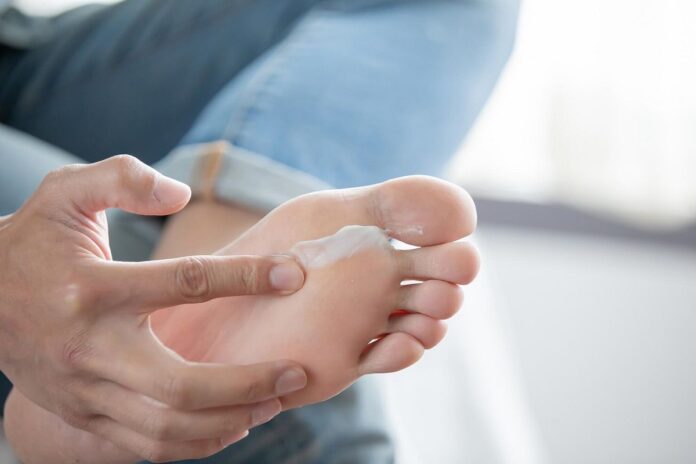Athlete’s foot, also called tinea pedis, is the most common infection of the skin. Despite its popular name, you don’t have to be an athlete to get it, and it can develop in places other than locker rooms or gym showers. In hot, muggy conditions, it happens more frequently. Athlete’s foot most commonly affects males in their teens or 20s, but children and women can get it, too.
The first sign of athlete’s foot is usually scaling and peeling between the toes. There may also be redness, itching tiny blisters, and scaling along the sides and soles of the feet. In more severe cases there may be cracks between the toes and the skin may become soft, painful, or discolored.
Once you have athlete’s foot, it’s important to treat it. This fungal infection usually doesn’t go away on its own. People with diabetes must be especially attentive to identifying athlete’s foot, as it can be a major trigger for more serious bacterial infections.
Table of Contents
What causes athlete’s foot?
Trichophyton is the name of the most common group of fungi that causes athlete’s foot; other fungi may cause this as well. (The similarly itchy condition around the groin known as jock itch is also often due to Trichophyton).
Also Read: 8 Ways to Invigorate Your Feet
You get athlete’s foot by coming in contact with the fungus—for example by walking barefoot across a locker room. The fungus thrives best in warm, moist, enclosed environments. A breeding environment is created by moist, sweaty socks and snug, poorly ventilated shoes. Your chances of catching athlete’s foot from another person are slight, but the fungus can be spread to others by fragments of affected skin that have been shed.
What if you do nothing?
Athlete’s foot should not be ignored. The condition can be easily treated, but if allowed to progress it becomes extremely bothersome and more resistant to treatment. Untreated athlete’s foot can also lead to serious, secondary bacterial infections.
Home remedies for athlete’s foot
Once you know that you have athlete’s foot, treat it immediately. Treatment primarily revolves around alleviating symptoms, reducing the risk of acquiring a secondary infection, and reducing the risk of spreading the infection to others. The usual treatment for athlete’s foot is an over-the-counter antifungal cream, lotion, or powder containing antifungal agents such as clotrimazole.
Apply the cream on the soles of your feet. For between your toes, lotion or powder may be more effective. These are more quickly absorbed than the cream and won’t trap moisture, which could prolong the problem.
Also Read: Home Remedies For Cracks On Feet
Usually, three consecutive days of treatment should clear up most of the symptoms of athlete’s foot. It’s common to assume that the infection has ended when the itching is gone and there is no sign of redness or cracking on the skin, but this is not true. In fact, six or more weeks of treatment are usually necessary to resolve the infection and prevent a relapse.
How to prevent athlete’s foot
Some people are more susceptible to the athlete’s foot fungus than others. If you are susceptible, follow these commonsense rules, especially when you’re very active and your feet tend to perspire.
- Keep your feet clean. Washing your feet daily with soap and water is a good idea. Be sure you dry your feet thoroughly, especially between the toes (you can use a hair dryer on low heat). Dry your feet last or use a separate towel.
- After drying, apply antifungal lotion. In order to prevent fungal development, use an antifungal foot powder that doesn’t include cornflour after this.
- Choose ventilated shoes. This allows your feet to breathe. Also, don’t wear the same pair of shoes every day, so that your shoes have a chance to air out.
- When you can, go barefoot. The next best thing to bare feet is to wear sandals.
- When you wear shoes, wear socks, too. The best protection comes from socks made of synthetic materials (such as polypropylene) that wick away moisture. Change your socks daily.
- To prevent recurrence, take medication even after symptoms disappear. Recurrence of athlete’s foot is usually a result of discontinuing medication too soon. It is important to remember to continue the full course of treatment even after symptoms go away. Frequently, this takes longer than six weeks.
When to call your doctor about athlete’s foot
Contact your doctor if the area turns red and swollen, or if there is drainage, or if nonprescription medication has provided no relief after two weeks.
What your doctor will do
Typically, your doctor will examine your feet and, using a surgical blade, take a skin scraping that will be scrutinized under a microscope for fungal growth. Your doctor may also get a fungal culture to confirm the diagnosis and identify the specific species causing the infection. If the problem is a minor case of athlete’s foot, your doctor will probably prescribe an antifungal lotion or powder. Severe or intractable cases can be treated with any of several newer oral antifungal agents.




